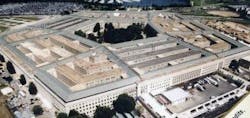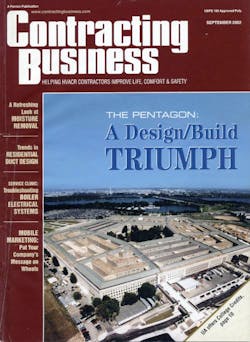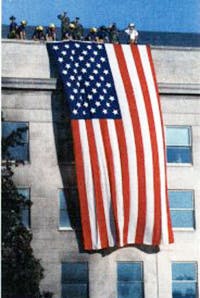This Month in HVACR History -- HVAC, the Pentagon and 9/11
Our nation recently commemorated the dark day that was September 11, 2001, a day of terrorism-by-aircraft on the World Trade Center, the Pentagon, and a crash that killed 40 passengers and crew of United Airlines Flight 93 in a field in Shanksville, Pa.
The Pentagon attack took 125 lives, when hijacked American Airlines flight 77 slammed into the "Wedge 1" section of the building.
Contracting Business documented the multi-year Design/Build renovation of The Pentagon in its September 2002 edition, in "The Pentagon: A Triumph of Design/Build," by David Peters, then senior vice president of engineering for Southland's Mid-Atlantic Division; and Mike Miller, Southland Industries' project executive for the Pentagon Renovation Program.
Most of the nation was unaware that the renovation had begun in 1998, and was moving along according to schedule at the time of the attack.
In a sidebar to the article, CB senior editor Ron Rajecki reported that the Pentagon renovation of Wedge 1 was just being completed, and there were not as many people in that immediate area on the morning of the attack.
Workers from Southland Industries, Irvine, Calif., and general contractor Hensel Phelps, Greeley, Colo., were moving on to the next phase of the project, in Wedges 2 through 5, when the plane plowed into the building.
Rajecki reported that about 2 million sq. ft. of office space was damaged, by the explosion, fire, water and smoke. However, the renovation had resulted in improvements that helped mitigate the disaster somewhat. The life, fire and safety codes in Wedge 1 had just been improved, including the installation of a new sprinkler system. New blast-resistant 1,600-lbs. window units had also been installed on Wedge 1's outer wall. Each window unit was held in place by 6-in. steel tubing that runs through all five of the building's floors, the authors reported.
"When the plane hit the building, those steel tubes and blast resistant windowsThe entire Pentagon Design/Build renovation included a chilled water/fan powered induction unit system that Southland Industries chose to handle the unique comfort and efficiency challenges presented by the size and design of the building.
Due to security concerns, the teams were directed to fast-track the remaining renovations and of course, the reconstruction of the destroyed regions of the building. They were directed to cut four years off the original timeline. However, subsequent additions to the renovation plan pushed the completion date to June, 2011.
About the Author
Terry McIver
Content Director - CB
As director of content for Contracting Business, he produces daily content and feature articles for CB's 38,000 print subscribers and many more Internet visitors. He has written hundreds, if not two or three, pieces of news, features and contractor profile articles for CB's audience of quality HVACR contractors. He can also be found covering HVACR industry events or visiting with manufacturers and contractors. He also has significant experience in trade show planning.


